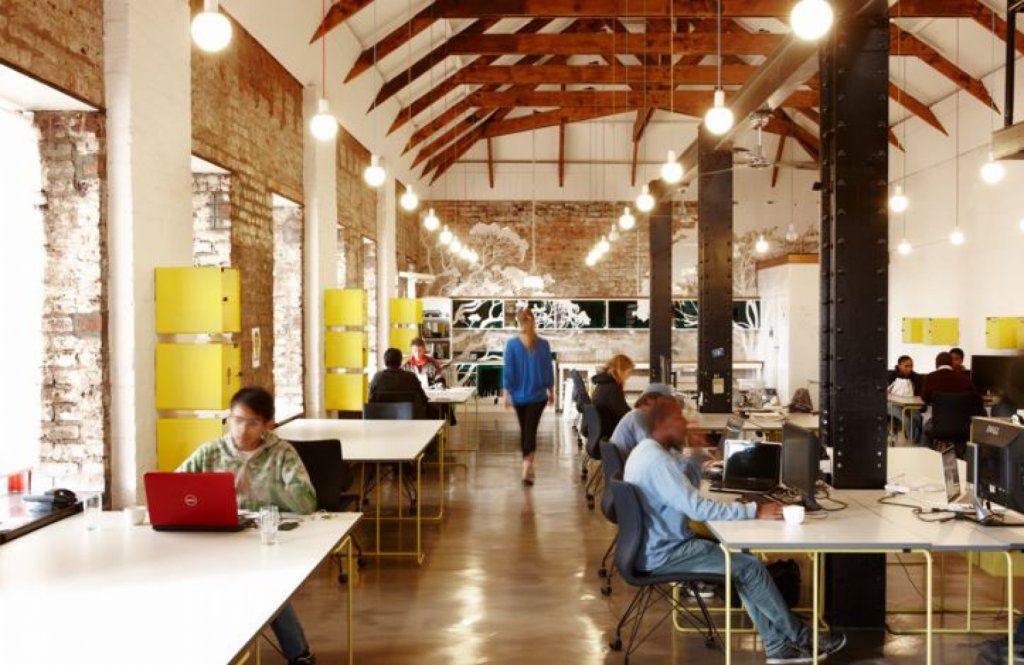Corporate America Opens Up to Co-Working

Coworking has really just been around for about a decade, and it’s already cutting its hair and putting on a tie. The practice was born in the start-up culture, favored by entrepreneurs, freelancers, and independent innovators. In recent years, co-working has matured, and is now an option that’s appealing to more structured corporate organizations as well.
Just so we’re on the same page: what is co-working? It’s been called an office where workers share the same roof but not necessarily the same boss, or “working alone together.” Basically it’s a work space that allows for independent activity in a shared space. Individuals or groups rent only the space they need, and have the opportunity to network and interact with others in the space if they’re so inclined. This can often foster a stimulating, creative, and collaborative environment.
Co-working has seen remarkable growth since its inception in 2005. The number of U.S. coworking spaces doubled from 2012 to 2013, and there are now an estimated 800+ in the U.S. These spaces have held great attraction for freelancers and entrepreneurs who are tired of working from home or the local coffee shop. Co-working provides a productive workspace as well as the opportunity for interaction that solo work often lacks. Working in a shared space often sparks new partnerships and ideas.
Research shows that co-working attracts those seeking “efficiency, economy, community, collaborative opportunities, social and educational benefits.” These aren’t only of interest to startups, and in the last couple of years more traditional corporations have begun to take advantage of these benefits as well.
In Boston, for example, the financial company State Street has developed a shared interdepartmental work space, which they call State Street Bank. This is a corporate co-working idea, and has the following features that set it apart from traditional spaces:
- Shared meeting rooms, storage, supplies (among departments)
- Flexible, more open seating
- Multipurpose communal space (cafeteria, lobby)
The space is intended to feature interdepartmental sharing of common space, multi-functional spaces, less individual space and more collective space, to allow for greater collaboration across the company.
Other corporations are seeing the benefits of co-working as part of a relocation. General Electric moved 20 workers from its new energy business, Current, into a WeWork space near Boston’s South Station. GE is preparing its new Boston headquarters. As staff is gradually brought up to capacity, co-working allows for cost savings. In some cases, per worker costs for co-working spaces can be as much as 35% lower than through a traditional commercial lease. This takes into consideration the ease of moving staff in and out, as well as the flexible terms available through a co-working arrangement.
In addition to being more practical at times, co-working spaces are often amenity-rich, ideally located, and feature a trendy design. These features can be terrific for recruiting. As the millennial generation takes its place at the helm, workers are looking for more opportunities for collaboration and interaction at the workplace. Coworking spaces provide a wealth of networking opportunities, and many include educational programming and professional development opportunities right on site.
This, combined with flexible leasing terms and the potential for cost savings, makes co-working a solution for large organization as well as independent individuals. Coworking companies continue to evolve, reinventing the workplace from one size fits all to fit for all sizes.
A Trusted Guide in Commercial Real Estate
Coldwell Banker Commercial® provides Commercial Real Estate Services from Property Sales and Leases, to Property Management. Learn how our expansive network of Independently Owned and Operated Affiliates and Real Estate Professionals use their in-depth knowledge of the local market and industry trends to help businesses and investors navigate the complexities of the commercial real estate landscape.






